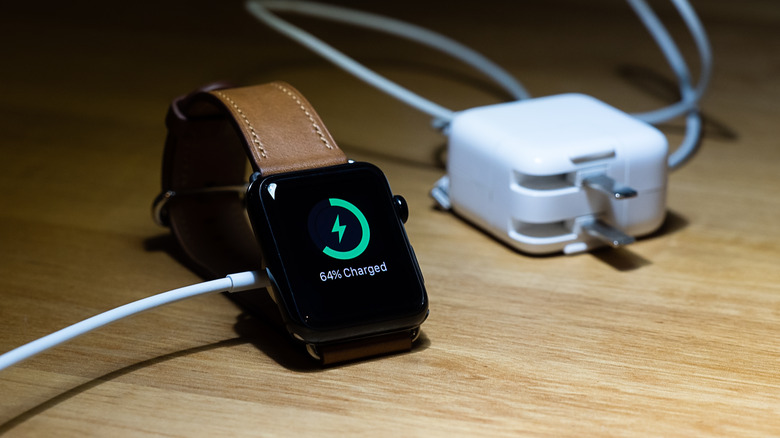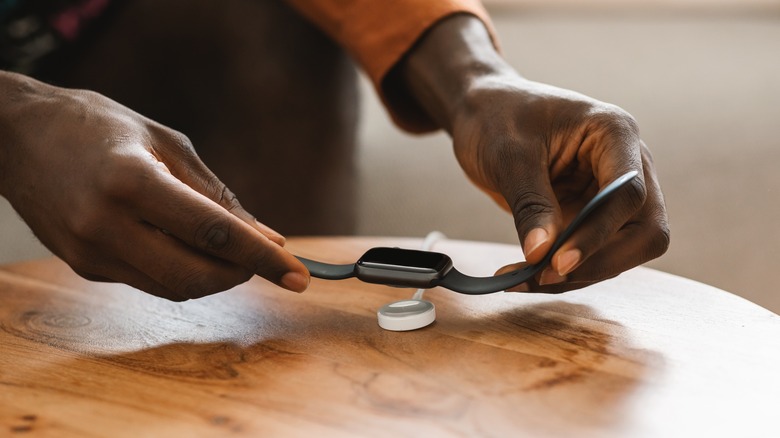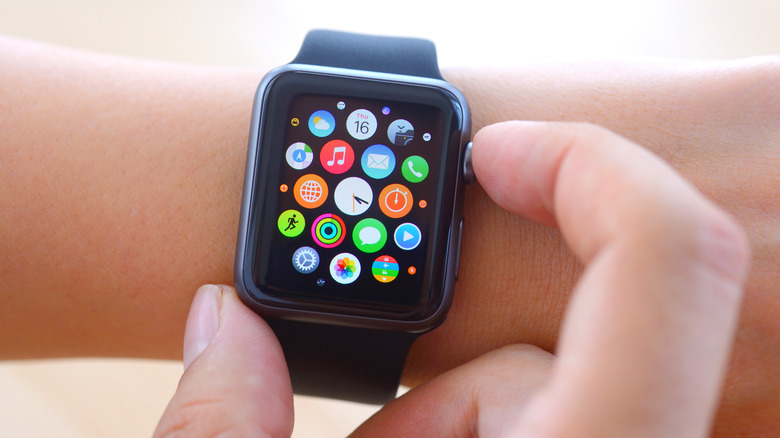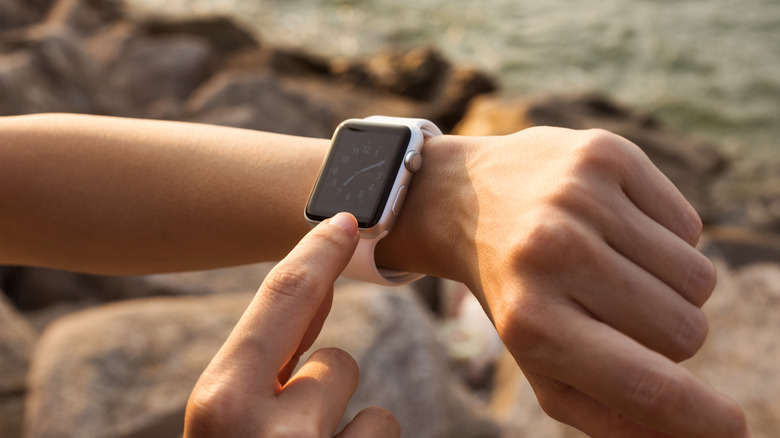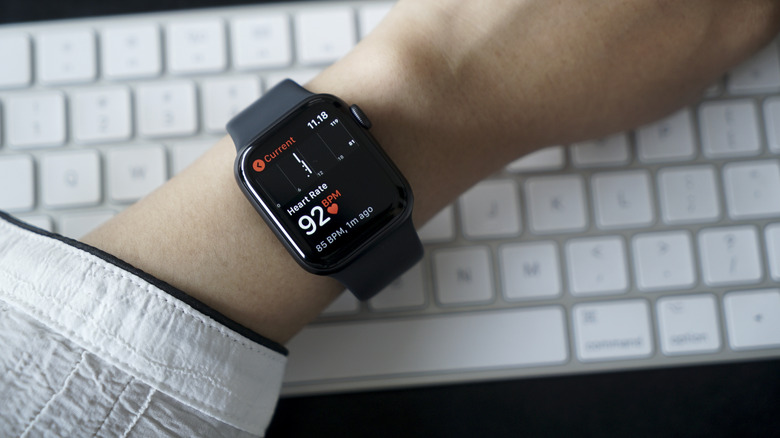3 Things To Look Out For If Your Apple Watch Is Not Charging
When it first launched in 2015, the Apple Watch quickly became a crowd favorite for people who love wearables, especially those already invested in the Apple Ecosystem. Through the years, the Apple Watch has evolved to have more advanced features, including improved battery life. For example, the first-generation Apple Watch only promised up to 18 hours of battery life per overnight charge. On the other hand, some of its latest models, such as the Apple Watch Ultra 2, can last as long as 72 hours in low-power mode.
However, while the Apple Watch battery can hold its own against other smartwatches, it can still have problems. Once it stops charging or the red lightning bolt icon shows up, you know that something is up. According to Apple, the red lightning bolt icon can mean anything from entering low battery mode to problems with the charging cable. Although there is no official expected battery life span, Apple does share that its Watch batteries are designed to retain up to 80% of their original capacity for only up to 1000 complete charge cycles. While its actual battery lifespan will depend on how well you've taken care of your Apple Watch, some users have claimed their batteries begin to fail after two years of use in the Apple Community forums.
So if your Apple Watch isn't charging, don't worry. Here are some issues to look for and how to fix them.
Hardware issues
If your watch isn't charging, one of the first things to do is check the charging hardware: the cable, charging block, and Apple Watch contact point. To do this, you'll need to isolate and test certain part individually.
First, you can try to clean the charging contacts, which are located in the back of your Apple Watch. To remove debris or dirt, you can wipe it with a lint-free cloth. For cleaning your smartwatch, Apple recommends using 70% isopropyl alcohol wipes, 75% isopropyl alcohol wipes, or Clorox Disinfecting Wipes.
To check the cable, first do a visual inspection for any cuts or exposed wires. Then, make sure that your charging cable and block are securely connected to an outlet. If it is still not working, try using the cable with a different charging block, outlet, or USB port. After you identify which part of your charging hardware has issues, you can simply replace it. For maximum reliability, stick to official Apple Watch charging blocks and cables.
If your hardware checks out but you still aren't charging, there may be another issue, such as software.
Pending software updates
Sometimes, a failing Apple Watch battery can be attributed to software problems. Aside from improved battery life, software updates deliver security patches and device optimization. In some cases, they can also cause problems. In 2023, several Apple Watch owners on the Apple Community forums reported battery problems after updating their smartwatches with WatchOS 10.0.1.
If enough customers complain, Apple may issue another update to resolve the concern. To avoid your Apple Watch freezing during the update, it's recommended to keep it plugged in throughout the update process. At minimum, charge it to at least 50%. Additionally, you should make sure that you have a stable Wi-Fi connection and enough storage space to fully update your operating system. If not, you put your smartwatch at risk of data corruption. If you've updated your Apple Watch and the charging issue remains, you can force reset it by holding down the side button and the Digital Crown. Release once the Apple logo comes into view.
When all else fails, you can factory reset your Apple Watch. This effectively reverts your smartwatch to its original software, removing complications that might have arisen from a recent update. To do this, open your Apple Watch and go to your Settings. Next, tap General > Reset > Erase All Content and Settings. Then, tap the Erase All button to confirm your decision.
Temperature issues
Unlike other devices, which are typically used indoors, you're likely to take your Apple Watch into more demanding environments. As a companion for all kinds of adventures, your Apple Watch can face unsuitable operating conditions, especially when it comes to heat.
Some regular activities, such as making calls in a location with a poor or weak signal, can also lead to overheating. Unfortunately, this can cause issues with your Apple Watch, including charging. Apple recommends an ambient temperature between 32 degrees to 95 degrees F (0 and 35 C) for most Apple Watch models. Apple also suggests the Apple Watch be stored in ambient temperatures between -4 degrees and 113 degrees F (-20 and 45 C) when not in use. Some Apple Watch models, such as the Ultra, can handle more extreme temperatures.
Should your Apple Watch experience higher than acceptable temperatures, it may display a red thermometer next to the time. Other signs of overheating might include losing phone signal, apps closing by themselves, data transfers slowing down, and even charging stopping altogether. To maintain recommended ambient temperature, Apple recommends removing your watch from your wrist and charger. Then, move it to a cooler place and let it cool down before attempting to charge it again.
Get more out of your Apple Watch
At the end of the day, your Apple Watch will work best when you take good care of it. If you let maintenance slide, you're likely to encounter frustrating issues with your device.
In some cases, however, maintenance and simple fixes like the above won't do the job. It's possible your Apple Watch has a factory defect. If you suspect that this is the case, consult Apple support or schedule a visit with an authorized repair center for an evaluation. The Apple Limited Warranty offers battery service coverage, including the Apple Watch itself and the other accessories that come with the box. Depending on the Apple Watch model, the warranty period will vary. In addition, if you bought accessories separately, they should be covered by their own limited warranty.
You can check if your Apple Watch and its accompanying accessories are still covered here. Either log into your Apple account or manually type the serial code, fill out the CAPTCHA, and hit "submit." Should your Apple Watch still have an active AppleCare+ subscription, your battery can be replaced for free if it retains less than 80% of its original battery capacity. Or, if your Apple Watch is no longer under warranty, you can participate in a trade-in program, pay for the battery replacement out-of-pocket, or sell the broken Apple Watch for parts.
